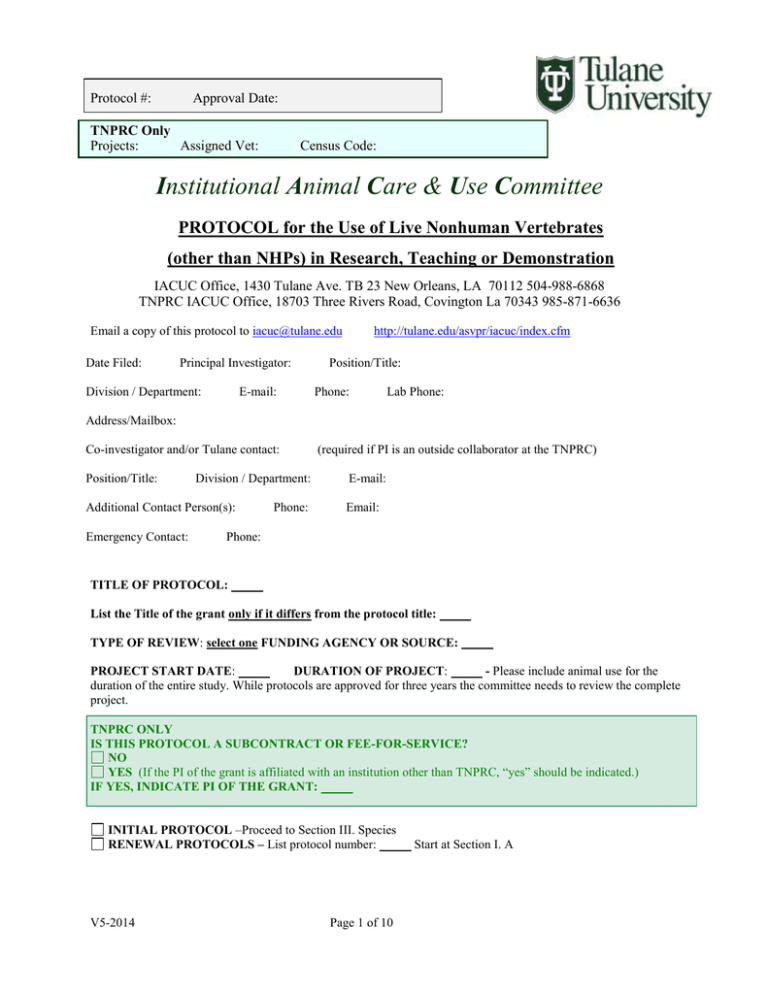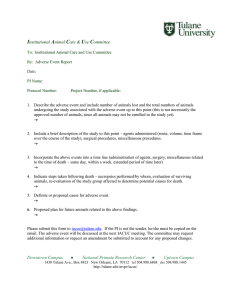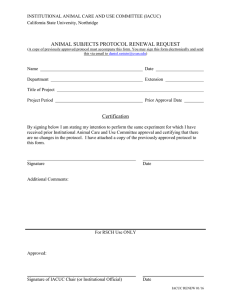I
advertisement

Protocol #: Approval Date: TNPRC Only Projects: Assigned Vet: Census Code: Institutional Animal Care & Use Committee PROTOCOL for the Use of Live Nonhuman Vertebrates (other than NHPs) in Research, Teaching or Demonstration IACUC Office, 1430 Tulane Ave. TB 23 New Orleans, LA 70112 504-988-6868 TNPRC IACUC Office, 18703 Three Rivers Road, Covington La 70343 985-871-6636 Email a copy of this protocol to iacuc@tulane.edu Date Filed: Principal Investigator: Division / Department: E-mail: http://tulane.edu/asvpr/iacuc/index.cfm Position/Title: Phone: Lab Phone: Address/Mailbox: Co-investigator and/or Tulane contact: Position/Title: Division / Department: Additional Contact Person(s): Emergency Contact: Phone: (required if PI is an outside collaborator at the TNPRC) E-mail: Email: Phone: TITLE OF PROTOCOL: List the Title of the grant only if it differs from the protocol title: TYPE OF REVIEW: select one FUNDING AGENCY OR SOURCE: PROJECT START DATE: DURATION OF PROJECT: - Please include animal use for the duration of the entire study. While protocols are approved for three years the committee needs to review the complete project. TNPRC ONLY IS THIS PROTOCOL A SUBCONTRACT OR FEE-FOR-SERVICE? NO YES (If the PI of the grant is affiliated with an institution other than TNPRC, “yes” should be indicated.) IF YES, INDICATE PI OF THE GRANT: INITIAL PROTOCOL –Proceed to Section III. Species RENEWAL PROTOCOLS – List protocol number: V5-2014 Page 1 of 10 Start at Section I. A SECTION I. RENEWAL PROTOCOLS ONLY Please enter a brief summary of what has been accomplished thus far so that the continuation efforts described in this protocol can be better understood. Please include any relevant publications from your study. SECTION II. ANIMALS CURRENTLY ASSIGNED (animals housed in the animal facility) Animals are currently in the DCM animal facility. Please note that animals must be transferred when the renewal protocol is approved. Comment if needed: SECTION III. SPECIES, NUMBER & CATEGORY OF ANIMAL USE SPECIES STRAIN NUMBER . . . . . . COMMENT: *USDA CATEGORY . . . . . . *http://tulane.edu/asvpr/iacuc/index.cfm for detailed description of each USDA category IMPORTANT All questions must be answered in order for the protocol to undergo IACUC review. Do not refer to or attach passages from grants. SECTION IV. REGULATORY INFORMATION A. Please check YES or NO as it applies to the species requested. If you answer YES to a question, you must provide an explanation and justification. 1. Is this an endangered or threatened species? No Yes 2. Is short-term (> 30 minutes; < 12 hours) physical restraint of a conscious animal employed? No Yes 3. Is long-term (12 hours or more) physical restraint of a conscious animal employed? No Yes 4. Will specialized management procedures be required, e.g. specialized caging equipment, restricted or altered feeding/watering/sanitization schedules, or environmental parameters such as cage size, temperature, lighting or other fall outside the “Guide for the Care and Use of Laboratory Animals”? No Yes V5-2014 Page 2 of 10 5. Will you perform more than one major survival surgery on any animal? PLEASE NOTE: major survival surgery penetrates and exposes a body cavity or produces substantial impairment of physical or physiologic functions (such as laparotomy, thoracotomy, craniotomy, joint replacement or limb amputation). No Yes 6. Will animals be housed outside of AAALAC-accredited Tulane facilities for over 12 consecutive hours? If YES, the proposed site must be inspected and approved by the IACUC prior to use. Please list the location with justification below. No Yes Please complete Appendix A http://tulane.edu/asvpr/iacuc/hsc/deadlines.cfm 7. Will pain or distress without the use of analgesic or anesthetic agents occur during the course of experimentation? This is Category E and must be scientifically justified with references. No Yes 8. Will these procedures be filmed, videotaped or photographed for use outside the institution? If so, you must obtain approval from the Executive Director of Comparative Medicine. (985-871-6285) No Yes 9. Does this protocol include a breeding colony? No Yes - Please complete the Breeding Appendix located at http://tulane.edu/asvpr/iacuc/hsc/deadlines.cfm SECTION V. PERSONNEL HAZARDS A. Is there potential exposure of humans to chemical hazards, physical hazards, radioactive agents, or biohazardous agents during the course of animal experimentation? No Yes - please respond to the choices below. 1. 2. 3. 4. Physical Chemical Radioactive Indicate the hazard: Indicate the hazard: Indicate the hazard: Biohazard / Recombinant DNA Indicate the hazard: Does this biohazard require IBC approval? http://tulane.edu/asvpr/biosafety/committee/index.cfm Yes, please provide the IBC# No Personnel from the Office of Biosafety or the Office of Environmental Health and Safety may contact you for additional information or completion of forms. SECTION VI. NON-TECHNICAL SUMMARY Using non technical language (lay) that a layperson with no scientific background would understand, provide a brief summary that describes the nature and purpose of the this study and its potential value to human or animal health the advancement of knowledge or the betterment of society. Do not use scientific jargon, acronyms or abbreviations and do not cut and paste from grant applications. V5-2014 Page 3 of 10 SECTION VII. COMPLETE DESCRIPTION OF ANIMAL USE A. HYPOTHESES - Please state your hypotheses in this section but do not cut and paste passages from your grant application. It is recommended that you limit this to approximately 20 lines. B. DESCRIPTION - Provide a concise description including all steps, in chronological order, the experimental course of an animal from its entry into the experiment to the endpoint of the study. It is recommended that you provide a table or tables, which includes the Animal Group Composition, Sampling, Procedures, Drugs, Compounds and Time points. Please provide a table title reference if using more than one table. Insert table C. STANDARD OPERATING PROCEDURES (SOPs) Procedures may reference an approved TULANE SOP/Policy in lieu of a complete description. Please choose all of the SOPs that will be used on your study. SOP/policies listed here are available at http://tulane.edu/asvpr/iacuc/hsc/sops.cfm or contact the IACUC office. If there is no approved SOP then a complete description must be included in VII.B. . . . . . . . . . . D. PROPOSED TREATMENTS ALLEVIATION OF PAIN AND DISTRESS: Describe the use of analgesics, anesthetics, and tranquilizing drugs to minimize discomfort, distress, pain or injury. The list below contains some common drugs and doses and must be checked if they will be administered in this protocol. Guidelines for Rodent & Rabbit Analgesia and Tranquilization & Euthanasia Methods available at http://tulane.edu/asvpr/iacuc/hsc/sops.cfm MOUSE AND RAT DRUG DOSE ROUTE Preanesthetic Atropine 0.05 mg/kg IM/SC Anesthetic Drugs Ketamine/Xylazine 80-110/5-10 mg/kg IM/IP Pentobarbital 50-80 mg/kg IP Isoflurane gas 1-5% in oxygen, to effect Inhalation Analgesic Drugs Buprenorphine 0.05-0.1 mg/kg IM/SC/IP Caroprofen 1-2 mg/kg SC/PO Meloxicam 1-2 mg/kg SC/PO Local anesthetics/analgesics (can be combined in same syringe) Lidocaine 0.5%, maximum dose 7 SC/intramg/kg incisional Bupivicaine 0.25%, maximum dose 8 SC/intra- V5-2014 Page 4 of 10 FREQUENCY Prior to anesthesia As needed As needed Continuous BID-TID BID SID Fast onset, but short duration (1 hour) Slow onset, but long duration (4-8 hours) mg/kg incisional OTHER analgesics, anesthetics, and tranquilizing drugs that will be used: RABBIT DRUG Preanesthetic Drugs Glycopyrrolate Sedative Drugs DOSE ROUTE FREQUENCY 0.01 mg/kg IM/SQ Prior to anesthesia 1/0.02 mg/kg IM/SQ Acepromazine/Buprenorphine Ketamine/Diazepam 20-25/1-3 mg/kg IM/SQ Anesthetic Drugs Isoflurane gas 1-5% in oxygen, to effect Inhalation Ketamine/Xylazine 20-35/1-3 mg/kg IM Analgesic Drugs Buprenorphine 0.01-0.05 mg/kg IM/SQ Meloxicam 0.1-0.2 mg/kg IM/PO OTHER analgesics, anesthetics, and tranquilizing drugs that will be used: As needed As needed Continuous As needed BID Once daily PIG DRUG DOSE ROUTE Preanesthetic Atropine 0.04 mg/kg IM/SC Anesthetic Drugs Tiletamine4-6/2-3 mg/kg IM/IV Zolazepam/Xylazine Pentobarbital 40-50 mg/kg IV Isoflurane gas 1-5% in oxygen, to effect Inhalation Analgesic Drugs Buprenorphine 0.05-0.1 mg/kg IM Local anesthetics/analgesics (can be mixed and combined in same syringe) Lidocaine 0.5%, maximum dose 7 SC/IT/intramg/kg incisional Bupivicaine 0.25%, maximum dose 8 SC/IT/intramg/kg incisional OTHER analgesics, anesthetics, and tranquilizing drugs that will be used: FREQUENCY Prior to anesthesia As needed As needed Continuous BID Fast onset, but short duration (1 hour) Slow onset, but long duration (4-8 hours) List all drugs, agents, compounds, and substances that are introduced to the animals throughout the study period as described in the complete description. SELECT TYPE . . . . . V5-2014 NAME DOSE Page 5 of 10 ROUTE IN VIVO RADIONUCLIDE(s) INSECT VECTORS VOLUME NUMBER MODE E. VETERINARY CARE Routine care as specified in the standard operating procedures Division of Veterinary Medicine (985-871-6266) http://www.tnprc.tulane.edu/index.shtml Department of Comparative Medicine (504-988-5211) http://tulane.edu/asvpr/dcm/index.cfm Special care. Provide a plan of action including phone numbers of essential personnel. F. ADVERSE EFFECTS /CLINICAL ENDPOINTS Please list any adverse effects or reactions that have been documented or could be expected from the use of the test article (drug, antibody, other material) during the study. If none are expected, please state that. Please list what treatment plan(s) will be employed in response to such should they be noted during the course of this research. G. ENDPOINTS To review the Policy of Humane Experimental Endpoints in Rodent Research, please click on this link: http://tulane.edu/asvpr/iacuc/hsc/sops.cfm The Policy of Humane Experimental Endpoints in Rodent Research is acceptable for this study. The endpoints for this study are time based and noted on the Experimental Design Section VII.B. However, if an animal’s physical condition deteriorates the Policy of Humane Experimental Endpoints in Rodent Research is acceptable for this study. There is NO ENDPOINT to this study other than the approved study period and euthanasia is not required. However, if an animal’s physical condition deteriorates the Policy of Humane Experimental Endpoints in Rodent Research is acceptable for this study. I choose not to use the Policy of Humane Experimental Endpoints in Rodent Research - Please list the criteria to use to determine when euthanasia will be performed. H. EUTHANASIA METHOD Indicate the method to be used; include dosage and route of administration for each species indicated. Is the method listed above consistent with the recommendation of the AVMA Guidelines on Euthanasia? http://www.avma.org/issues/animal_welfare/euthanasia.pdf YES, the method listed above is consistent with the recommendation of the AVMA Guidelines on Euthanasia. V5-2014 Page 6 of 10 NO, it is not consistent. Please provide justification (supported with references) for not following the recommendation: SECTION VIII. ANIMAL USE JUSTIFICATION A. RATIONALE FOR ANIMAL USE. It must include the reasons why non-animal models cannot be used. B. APPROPRIATENESS OF THE SPECIES SELECTED (Please address if preliminary studies have been conducted using other species or lower life forms.) C. ANIMAL NUMBER JUSTIFICATION Please identify one or more of the approaches listed below used to justify the number of proposed animals for this study and provide an explanation. Citation of previous research, with sufficient information provided to indicate that the previous research is similar enough in concept and methodology to make it reasonable to use similar sample sizes in the proposed research project. Explanation Statistical analysis- if numbers are chosen with the intent of obtaining statistically significant differences, the most objective tool is usually a power analysis to determine sample size. When groups are compared, the goal of conducting a power analysis is to determine the appropriate number of animals per group to ensure detection of a significant difference. Explanation Pilot study- the following information must be included: Main outcome measure being evaluated (e.g. reduction in tumor size) The definition of success (e.g., a 50% reduction in tumor size in 3 animals) that would indicate that the study should be followed up by a full study. Explanation Teaching /Training Explanation Is your study a Category D or E? No - Proceed to Section X. Yes - Please complete Section IX. SECTION IX. ALTERNATIVES TO PAINFUL AND DISTRESSFUL PROCEDURES As required by Policy 12 of the Animal Welfare Act, “the IACUC is required to assure that the principal investigator has considered alternatives to procedures that may cause more than momentary or slight pain or distress” and “that the PI has provided a written narrative description of the methods and sources, such as the V5-2014 Page 7 of 10 Animal Welfare Information Center, Biological Abstracts, Index Medicus, PubMed, and the Current Research Information Service.” Alternatives are defined as new methods that refine existing usage by minimizing animals’ distress such as the use of analgesics, reduce animal usage such as the use of certain experimental designs, or replace whole animal tests with other procedures such as the use of in vitro analyses. Database Used Date of search Period covered by search Keywords used Number of relevant references Were alternatives found If alternatives were found, justify why they are not being used. Additional relevant sources may include scientific meetings, scientific discussion, consultation with veterinary staff and federal law or other legal guidelines. Please list below. SECTION X. ENVIRONMENTAL ENHANCEMENT Tulane University houses all rodents, guinea pigs and rabbits according to Tulane standard operating procedures (SOPs). In addition, all animals are group housed, when compatible, and provided with various nesting materials and/or cage manipulanda, when appropriate. SELECT HOUSING/ENRICHMENT CATEGORY PER SPECIES SPECIES . . . . HOUSING / ENRICHMENT . . . . *EXPLANATION / JUSTIFICATION Standard Enrichment at Tulane University Mice: Group Housing, Nesting Material Rats: Group Housing, Hides/Tunnels Dogs: Group Housing, Resting Boards, Toys, Human Interaction, DCM Dog Exercise Program Cats: Group Housing, Resting Boards, Toys, Human Interaction Pigs: Group Housing, Toys, Human Interaction Rabbits: Group Housing, Toys, Feed Supplement, Human Interaction If you need additional information or would like to request additional options for enrichment (see below) please contact: DCM Downtown – 504-988-5211 DCM Uptown 865-6717 TNPRC - Small Animal Veterinarian at 985-871-6496 and/or Small Animal Supervisor at 985-871-6348 Options for Additional/Alternative Enrichment Mice: Toys, Feed Supplement, Hides/Tunnels Rats: Toys, Feed Supplement, Human Interaction, Nesting Material Dogs: Feed Supplement Cats: Feed Supplement Pigs: Feed Supplement, Music Rabbits: Nesting Material, Music V5-2014 Page 8 of 10 SECTION XI. PERSONNEL Provide a listing of all personnel who will have direct contact with animals involved with the proposed experimentation. Do not list veterinary medicine staff involved with the daily husbandry. You must list each person’s role on the project. All individuals must be appropriately qualified and trained in the proposed animal care and use. NAME/ TITLE SPECIFIC ROLE ON PROJECT examples would be surgery, euthanasia, breeding colony maintenance, blood collection, behavioral studies or basic animal handling such as weighing or ear tagging. TRAINING List training or experience for roles or indicate that additional training is needed. If additional training is needed please state who will conduct the training and their years of experience. Outside Persons who will conduct procedures Persons who will conduct any procedure on-site must have completed the training and occupational health programs. All persons involved must complete the required training prior to the start of the project. DCM Downtown – 504-988-5211 DCM Uptown – 504-865-6717 TNPRC - Please contact the Occupational Nurse at 985-871-6596 to complete the necessary forms. NAME/ TITLE AFFLIATION SPECIFIC ROLE ON PROJECT -i.e. surgery, tissue collection, euthanasia, TRAINING - List training for role or indicate that additional training is needed. RISK ASSESSMENT AND HISTORY FORM (RAHF): All faculty, staff, and students who handle animals as a part of this protocol must participate in the Animal Handlers Health Surveillance Program to include the completion of the RAHF and the application of medical follow up as needed. For information or copies of these forms, please contact: Office of Environmental Health and Safety via email oehsrahf@tulane.edu or by telephone, 988-5486 (press 1) TNPRC staff only - contact the Occupational Nurse at 985-871-6596 Access the form at http://tulane.edu/oehs/ocsafety/animalhealthprogram.cfm SECTION XII. FACILITIES List all extra-vivarial rooms used for animal experimentation, demonstration, drug storage or housing. All animal rooms must be inspected and approved by the IACUC prior to animal use. Please contact the IACUC office for information on approved rooms. Please select the room use from the drop-down box (more than one use may be selected for each room) BUILDING ROOM # USE USE . . . . . . . . . . . . If use for a room is not in the above drop box listing, please describe: V5-2014 Page 9 of 10 USE . . . . SECTION XII. PRINCIPAL INVESTIGATOR CERTIFICATIONS 1. 2. 3. 4. 5. 6. 7. 8. I certify that the animal care and use described in this protocol is exactly as described in the funding application (if applicable) for this protocol. I certify that I have determined that the research proposed herein is not unnecessarily duplicative of previously reported research. I certify that all individuals working on this protocol are participating in the Tulane University Occupational Health and Safety Program. I certify that the individuals listed in Personnel, if noted to do animal work, are authorized to conduct procedures involving animals under this proposal, have received training in: the biology, handling, and care of this species: aseptic surgical methods and techniques (if necessary): the concept, availability, and use of research or testing methods that limit the use of animals or minimize distress: the proper use of anesthetics, analgesic, and tranquilizers (if necessary): and procedures for reporting animal welfare concerns. For all USDA Classification D and E protocols I certify that I have reviewed the pertinent scientific literature and have found no valid alternative to any procedures described herein which may cause more than momentary pain or distress, whether it is relieved or not. I certify that I will obtain approval from the IACUC before initiating any changes in this study. I certify that I will notify the IACUC regarding any unexpected study results that impact the animals. Any unanticipated pain or distress, morbidity, or mortality will be reported to the attending veterinarian and the IACUC. I certify that I am familiar with and will comply with all pertinent institutional, state, and federal rules and policies. I have read the assurances and I understand that failure to comply with these assurances may result in suspension or termination of this animal activity and the filing of a report of non-compliance with this Institution’s IO and appropriate governing agencies. Principal Investigator V5-2014 Date Page 10 of 10


